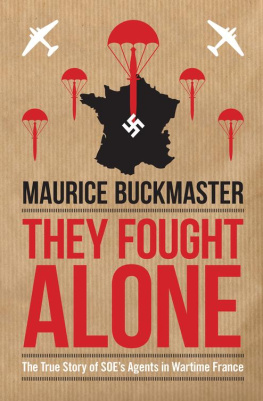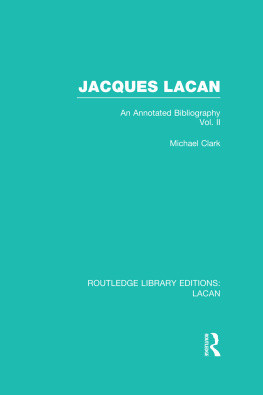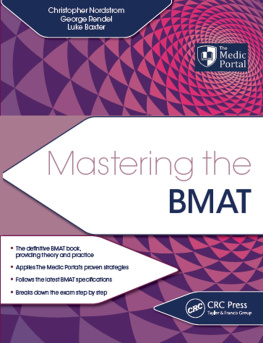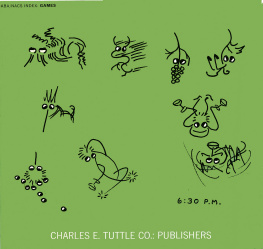First published 1988 by Leo Cooper Ltd.,
Leo Cooper is an independent imprint of the
Heinemann Group of Publishers, 10 Upper Grosvenor Street,
London W1X 9PA
LONDON MELBOURNE AUCKLAND
Copyright Marcel Ruby 1985
ISBN: 0-85052-6809
Printed in Great Britain by
St Edmundsbury Press Ltd, Bury St Edmunds, Suffolk
by Jean Pierre-Bloch
No one is better qualified to write this book than Marcel Ruby, author of numerous works on the French resistance and winner of the Comit dAction de la Rsistance award for literature. It is also a timely book. An epic saga of the British secret service agents and SOEs Buckmaster groups, it makes a thrilling story.
At a time when many writers, glossing over the horrors of mass deportation, are trying to impose their own ignoble version of resistance history, it is salutary to recall the days when France was struggling to repel the Nazis and their accomplices in the Vichy rgime. For this is the story that should be told. The first steps towards an organized resistance in France were taken by SOE. Many of us, among the first SOE agents, were unaware of what was happening in London, thanks to de Gaulles reservations about the British. In 1941, as far as we were concerned, the men who fell from the sky had been sent by de Gaulle, and that was all that mattered. But Marcel Ruby demonstrates how those early agents, both French and British, opened the door to a better understanding, so that London had a clearer idea of what was going on in France, and vice versa.
At that stage of the war, many of those who later proved their worth in the resistance were either counselling prudence or flatly refusing to offer us the slightest help. For them, Nazi Germany had won the war, was on the way to world domination, and we had better just accept it.
But as we proved, even in those early days, there was a movement towards resistance in France, doing all in its power to help the British in their lonely stand against Hitler.
Once again, let us thank Marcel Ruby for his lively and accurate account of the Buckmaster groups and their exploits.
1. Former minister, MP and chairman of LICRA, as well as one of the first agents in the Buckmaster networks.
All secret service agents, or so the general public fondly imagines, are supermen like James Bond. They live wildly exciting lives, unravelling machiavellian plots, courting death at every turn, performing feats of prodigious daring in defence of vital interests. Equipped with sophisticated weapons, they belong to a world of violence, alcohol and lovely women. And they always win.
The reality is very different. It often exceeds in dramatic intensity anything that cinema has been able to invent. The secret agent, man or woman, who undertakes such work is seldom prepared for the pitiless war in the shadows. With precious little else to help them, they must rely on their own courage and common sense to fulfil the impossible tasks they are set. They must watch themselves at every turn. But they are only human. They know what fear is; they know the constant anxiety of living in enemy territory where, nevertheless, they sometimes find real, true friendship and bravery. Sometimes even love. Sometimes prison, torture, deportation or death.
Winston Churchills orders to SOE and the Buckmaster groups were brutally simple: Set Europe ablaze!
And so, under the leadership of the legendary Colonel Buckmaster, men and women of exceptional strength of character threw themselves into the savage fight, their enthusiasm undimmed by all the risks.1
In the secret war, truth really was stranger than fiction. This book shows how honest citizens transformed themselves into redoubtable terrorists. How they made parachute landings by night, duly equipped with a cyanide pill just in case. How the reception committee was often missing or replaced by a German one. How three courageous brothers, then a handful of agents, managed to weave a veritable spiders web of resistance groups over the whole country.
How each group was organized: the logistics (utterly reliable people who hid arms, money, addresses of those responsible for local operations); the clandestine radio operators (whose role, apparently modest, was in fact essential and terribly dangerous for without them the agent was isolated and useless); and, of course, those who were directly responsible for taking action in the field.
How the agents were relentlessly pursued by the Gestapo and its allies, French collaborators. How they fell into traps, as at the Villa des Bois in Marseilles, or into the hands of Mathilde Carr (La Chatte), whose exploits were the subject of a recent film but who was finally used to hoodwink the Germans. How they fell victim to certain passeurs, those whose duty it was to lead them along the escape lines but who led them instead to imprisonment in the Spanish camp at Miranda; or were betrayed by people seeking to save their own necks or by others actively working for the Nazis. How certain highly regarded people made a pact of honour with the Germans and later paid the price for their mistake. But also how the imagination, cool heads and astonishing ingenuity of people like Ben Cowburn often served to outwit the enemy and his accomplices.
How the handful of Buckmaster groups managed to destroy vital economic and military targets usually by means of plastic explosives like the metal-pressing plant at Fives-Lilies, the propellor works at Ratier, the wireless factory at Ronchin, the Ducatillon oil refinery at Willems, the sluice at Roubaix, bridges, intricate machinery, trains carrying fuel or munitions, giant cranes, railway equipment, the main transformer for the submarine base at Bordeaux, etc., etc. How the famous Peugeot works at Sochaux, turning out cars and trucks and also tank turrets for the Wehrmacht, were put out of action with the knowledge and help of their owner, Robert Peugeot.
And above all, how Buckmasters people provided arms, training and active guidance to the maquisards and resistance workers, notably following the Normandy landings when they managed to delay a German tank regiment on its way to the battlefront. The reader may well be surprised to find some familiar names cropping up here.
From the SOE doctor interned in Buchenwald concentration camp, to the dainty elegant figure of a young Hindu princess who became an SOE heroine, shot in the back of the head at Dachau, the story of the Buckmaster groups could well be turned into a whole series of thrillers or spy films.
Marcel Ruby
1 May 1985
Suddenly appearing as if from nowhere, old Curly was already running towards us, making frantic gestures.
My god, where have you been? he yelled. Theyve been waiting for you for an hour, circling round and round. What the hell were you doing?
But it isnt time yet, we protested. We said midnight or one oclock, and its only what eleven twenty now.
Time or not, theyre here. And at that altitude itll be a miracle if everybody in the country hasnt spotted them.












 CONTENTS
CONTENTS 
